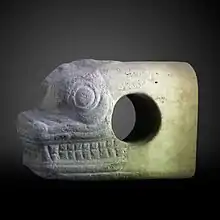Napirisha
Napirisha (Linear Elamite: ![]()

Napirisha is depicted as an anthropomorphic deity, often with a snake figure that symolises primordial waters.[2] It is thus identified with the Mesopotamian god Enki/Ea, who rules the primordial waters of the abyss. In Elam, he was close to the character of Humban, the great god of the Awan region, which he replaced as a titular deity of Elamit kings around 2000 BCE.
In Anshan, Napirisha did not have a main temple. Napirisha was in all likelihood worshiped in large, open stone sanctuaries, such as Kurangun; he is probably the deity depicted on bas-reliefs with his consort (Kiririsha?) and other deities, providing life water. A large temple dedicated to Napirisha was built in Dur-Untash (Choga-Zambil), in Susa, shared with the local titular god Inshushinak. The template was next to a large ziggurat.
References
- Desset, François. "Nine Linear Elamite Texts Inscribed on Silver "Gunagi" Vessels (X, Y, Z, F', H', I', J', K' and L'): New Data on Linear Elamite Writing and the History of the Sukkalmaḫ Dynasty". Iran. 56 (2). ISSN 0578-6967.
- The Royal City of Susa: Ancient Near Eastern Treasures in the Louvre. Metropolitan Museum of Art. p. 118. ISBN 978-0-87099-651-1.